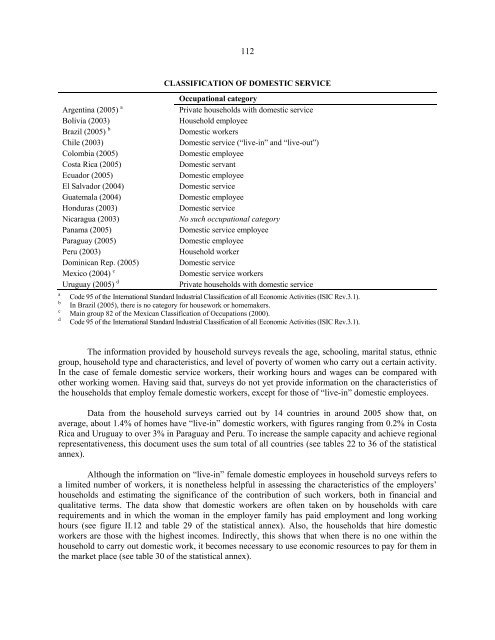Women in Latin America and the Caribbean - Cepal
Women in Latin America and the Caribbean - Cepal
Women in Latin America and the Caribbean - Cepal
You also want an ePaper? Increase the reach of your titles
YUMPU automatically turns print PDFs into web optimized ePapers that Google loves.
112<br />
a<br />
b<br />
c<br />
d<br />
CLASSIFICATION OF DOMESTIC SERVICE<br />
Occupational category<br />
Argent<strong>in</strong>a (2005) a<br />
Private households with domestic service<br />
Bolivia (2003)<br />
Household employee<br />
Brazil (2005) b<br />
Domestic workers<br />
Chile (2003)<br />
Domestic service (“live-<strong>in</strong>” <strong>and</strong> “live-out”)<br />
Colombia (2005)<br />
Domestic employee<br />
Costa Rica (2005)<br />
Domestic servant<br />
Ecuador (2005)<br />
Domestic employee<br />
El Salvador (2004)<br />
Domestic service<br />
Guatemala (2004)<br />
Domestic employee<br />
Honduras (2003)<br />
Domestic service<br />
Nicaragua (2003)<br />
No such occupational category<br />
Panama (2005)<br />
Domestic service employee<br />
Paraguay (2005)<br />
Domestic employee<br />
Peru (2003)<br />
Household worker<br />
Dom<strong>in</strong>ican Rep. (2005) Domestic service<br />
Mexico (2004) c<br />
Domestic service workers<br />
Uruguay (2005) d<br />
Private households with domestic service<br />
Code 95 of <strong>the</strong> International St<strong>and</strong>ard Industrial Classification of all Economic Activities (ISIC Rev.3.1).<br />
In Brazil (2005), <strong>the</strong>re is no category for housework or homemakers.<br />
Ma<strong>in</strong> group 82 of <strong>the</strong> Mexican Classification of Occupations (2000).<br />
Code 95 of <strong>the</strong> International St<strong>and</strong>ard Industrial Classification of all Economic Activities (ISIC Rev.3.1).<br />
The <strong>in</strong>formation provided by household surveys reveals <strong>the</strong> age, school<strong>in</strong>g, marital status, ethnic<br />
group, household type <strong>and</strong> characteristics, <strong>and</strong> level of poverty of women who carry out a certa<strong>in</strong> activity.<br />
In <strong>the</strong> case of female domestic service workers, <strong>the</strong>ir work<strong>in</strong>g hours <strong>and</strong> wages can be compared with<br />
o<strong>the</strong>r work<strong>in</strong>g women. Hav<strong>in</strong>g said that, surveys do not yet provide <strong>in</strong>formation on <strong>the</strong> characteristics of<br />
<strong>the</strong> households that employ female domestic workers, except for those of “live-<strong>in</strong>” domestic employees.<br />
Data from <strong>the</strong> household surveys carried out by 14 countries <strong>in</strong> around 2005 show that, on<br />
average, about 1.4% of homes have “live-<strong>in</strong>” domestic workers, with figures rang<strong>in</strong>g from 0.2% <strong>in</strong> Costa<br />
Rica <strong>and</strong> Uruguay to over 3% <strong>in</strong> Paraguay <strong>and</strong> Peru. To <strong>in</strong>crease <strong>the</strong> sample capacity <strong>and</strong> achieve regional<br />
representativeness, this document uses <strong>the</strong> sum total of all countries (see tables 22 to 36 of <strong>the</strong> statistical<br />
annex).<br />
Although <strong>the</strong> <strong>in</strong>formation on “live-<strong>in</strong>” female domestic employees <strong>in</strong> household surveys refers to<br />
a limited number of workers, it is none<strong>the</strong>less helpful <strong>in</strong> assess<strong>in</strong>g <strong>the</strong> characteristics of <strong>the</strong> employers’<br />
households <strong>and</strong> estimat<strong>in</strong>g <strong>the</strong> significance of <strong>the</strong> contribution of such workers, both <strong>in</strong> f<strong>in</strong>ancial <strong>and</strong><br />
qualitative terms. The data show that domestic workers are often taken on by households with care<br />
requirements <strong>and</strong> <strong>in</strong> which <strong>the</strong> woman <strong>in</strong> <strong>the</strong> employer family has paid employment <strong>and</strong> long work<strong>in</strong>g<br />
hours (see figure II.12 <strong>and</strong> table 29 of <strong>the</strong> statistical annex). Also, <strong>the</strong> households that hire domestic<br />
workers are those with <strong>the</strong> highest <strong>in</strong>comes. Indirectly, this shows that when <strong>the</strong>re is no one with<strong>in</strong> <strong>the</strong><br />
household to carry out domestic work, it becomes necessary to use economic resources to pay for <strong>the</strong>m <strong>in</strong><br />
<strong>the</strong> market place (see table 30 of <strong>the</strong> statistical annex).











